It's time for another first outing on Got A Ukulele for an independent ukulele builder. This is the intriguing Monoxyl Mezzo Soprano ukulele from Caravelle Kitchen.
A little while ago a chap called Matthieu Theuret from Saint-Georges-de-Didonne in western France got in touch asking if I would be interested in a review. Looking at his models I was highly intrigued, and that intrigue also led me to learn quite a bit along the way too, and not just ukulele things... Matthieu is a completely self taught ukulele builder who is actually a school teacher and does this on the side for a hobby. The name Caravelle Kitchen comes from his love of boats and cooking - a Caravel is a type of of Portuguese sailing boat (the spelling here being the French), and the 'Kitchen' bit comes from the cooking side. In fact he's published a street food cook book where each recipe comes with an original piece of ukulele sheet music for each recipe! Anyway, cool name, cool back story.
SUMMARY VIDEO REVIEW
The bridge is made of rosewood and is a simple, but nicely shaped, slot style bridge. It's clearly hand cut and a little rustic on the finishing, but it works. Sitting in that is a hand carved bone saddle with top compensation. Spacing here is 45mm.
There is no other decoration to the body other than a finishing in rubio oil, which is kind of like a Tru oil, though totally non-toxic and 'food grade', and also something that Antica Ukuleleria use. It gives it a very nice tactile finish in most areas but you should bear in mind this is very much hand made in the look and feel. There are one or two tooling marks in places, particularly around the heel and on parts of the sides which I know can bother some people. Personally, I like that it looks and feels hand made rather than by a factory line, but it would be wrong for me to not point it out. Generally though the body is pretty smooth though and I like how the spruce top is chamfered back where it joins the body. It also looks like the mahogany has been stained a little and I rather like some of what almost looks like 'burl' in the wood in places. I know some people mentioned finishing on some of the macro pictures I shared, but always remember - a macro lens can make even the finest finished ukulele look scruffy! But it IS hand made. Lets call it 'artisanal'..
Inside is interesting. The back is braced normally and the top is braced vertically but also with strengthening pieces either side of the sound hole. There is no top kerfing, but I suspect that is because the sides are thicker than a regular uke giving it the purchase it needs. There also seems to be some sort of integral tail block too.
The neck is integral to the body so there is no joint and tapers down to a D shaped profile which measures 36mm at the nut and about 29mm G to A. I love the look of the grain and the rounded shaping detail at the top of the body to create the heel. Embedded in the back of the neck is a strip of ebony wood for additional strength which is a nice touch. The back of the neck is really smooth and nice to hold in the hand.
The fingerboard is not applied but is part of the carving of the mahogany block complete with a curved end piece that overlaps the spruce top which is clever. It's not edge bound as it doesn't need to be as he has fitted semi-hemi dressed frets that sit in individual slots but don't reach the ends of the board. That also means they are extremely smooth without any sharpness. That's a really nice touch. There are 14 of those with an additional zero fret to set the string height, with a wooden 'nut' behind it to set the spacing. The body joint is at the 14th too which is more trad concert than soprano. Position dots in white pearl are fitted at the 5th, 7th and 12th, but sadly there are no side dots. That would be, I presume, something easy to specify with Matthieu but I'd certainly want them. The lack of dot at the 10th is also foxing me a little as it's a marker I personally gravitate to, but you'd soon learn to get around it.
Beyond the nut is an open frame headstock in Flea / Flight style. I actually think it's a touch too big for the overall size of the instrument. Not hugely so, but my eyes were certainly drawn to it. The finishing here, particularly inside the frame is much rougher than the rest of the neck and I think he should attend to that, though again it's a hand made instrument. It looks like the pilot holes for the tuner screws are drilled right through so they are visible on the inside too which may also irritate. There is no logo up here, but like the Magic Flukes, there is no room.
The tuners are side mounted gears in typical open headstock style in chrome with black buttons, though I have seen other examples of this model where he has fitted friction pegs, Flea style. I prefer this look myself, though the tuners themselves look fairly basic quality and their tensions do differ quite a bit. I'd suggest changing these.
Finishing it off are a set of Martin M600 fluoro strings and in this spec it would be €320 which, once again, is not a lot of money when you consider the man hours involved. Being a luthier build prices obviously differ depending on how you spec it, but he advises that the range is around €280 to €380. Either way, that's still not a lot of money for a hand made instrument outside of the far east.
I'm really rather taken with how different this is. I don't mind the hand finishing so much (though the headstock needs work) and I really like the look. It's also extremely light at only 460g and balances well. The setup is also bang on (thankfully considering the zero fret) and is set low at the 12th (just above 2.25mm)
The first standout for me here is the volume. For a thin bodied instrument this punches like an absolute cannon. There is seriously good projection here. The sustain is very good too and shimmery. I found both of these surprising considering how slight the body is.
Tone wise, an instrument with a spruce top and thin body I would expect to be bright and it certainly is that. It has a very crisp direct and clear sound that is particularly zingy. The Martin strings will also be contributing to that and, as I prefer a slightly mellower sound myself (subjective point, I know many who love the brighter sounds), I'd be experimenting with warmer strings. But it's more than just tone that concerns me with the string choice here as I am not convinced this is the best gauge either. The tension is a little lower than I would like and I found it quite easy to bend the strings sharp (as you will note in the video - that is NOT intonation, it's me!) - still, strings are easily changed and I rarely mark an instrument down for strings.
Strummed it has the bouncy peppy jangle that you want from a soprano instrument and think this would be great for playing jazzy chord progressions that suit that scale so well. Yet there is more going on here due to that sustain and the slightly longer scale that comes through when picking which is particularly pleasant and, I think, suits the bright tone much better. It has a music box twinkle that I am very taken with when played this way. There is great clarity on display here and the instrument projects with little effort on the playing hand.
I really should add a word on the subjective nature of reviews, and why my own tastes on core tone should not affect my scores objectively. Yes it's a little bit too bright sounding for me, but that is not the case for everyone and I have to concentrate on the core tone which is very good here. It's a well built instrument that works as a great ukulele.
So once again I am lucky enough to take a look at something quite different and really rather charming. It's honestly a pleasure to be able to spotlight names that you may not otherwise know and make a change from the usual big brands. There's a real cleverness to the idea here and whilst very much a home grown instrument does not fail to deliver on what it needs to do. The punch is terrific and am sure the brightness can be toned back with different strings or maybe a different top wood. But it works well regardless and is really not a lot of money for something hand made and quite different.
I'd add Matthieu to your interest list if you are looking for a break from the 'norm'.
Recommended!
UKULELE SPECS ROUNDUP
Name: Caravelle Kitchen Monoxyl
Scale: Mezzo Soprano (14 inch scale)
Body: Single carved piece of FSC mahogany with solid French spruce top
Bridge: Rosewood, slot style
Bridge: Rosewood, slot style
Saddle: Bone, compensated
Spacing at saddle: 45mm
Finish: Rubio oil
Neck: Integral to mahogany body
Fingerboard: Mahogany, integral to neck
Frets: 14 true frets plus zero fret
Nut: Wood nut for spacing, zero fret for height
Nut width: 36mm, 29mm G to A
Tuners: Unbranded chrome open gears
Strings: Martin M600 fluorocarbon
Weight: 460g
Weight: 460g
Country of origin: France
Price: €320
UKULELE PROS
Clever quirky looks and build
Great core build
Nice frets and neck
Terrific volume
Good sustain
Crisp clear tone
Great price
UKULELE CONS
Some 'artisanal' finishing in places
Tuners need improving
UKULELE SCORES
Looks - 9.5 out of 10
Fit and finish - 8.5 out of 10
Sound - 9 out of 10
Value for money - 9.5 out of 10
OVERALL UKULELE SCORE - 9 out of 10
UKULELE VIDEO REVIEW
GOT A UKULELE IS NOT PAID BY BRANDS OR SHOPS - YOUR KIND DONATIONS ARE WHAT KEEP THE SITE GOING! THANKS FOR YOUR HELP!
SAY THANKS WITH A BEER!
BECOME A GOT A UKULELE PATREON
OR THRU PAYPAL
THANKS!



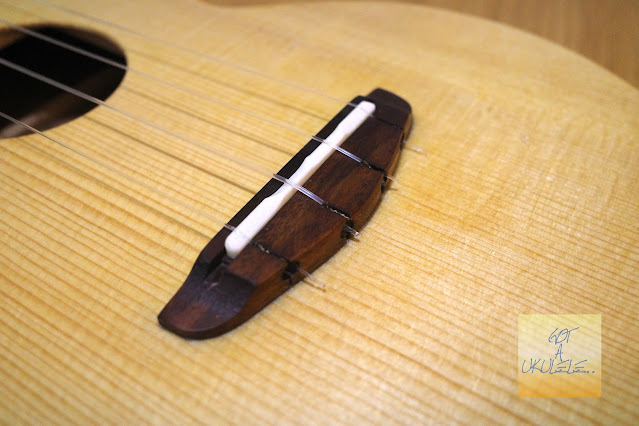
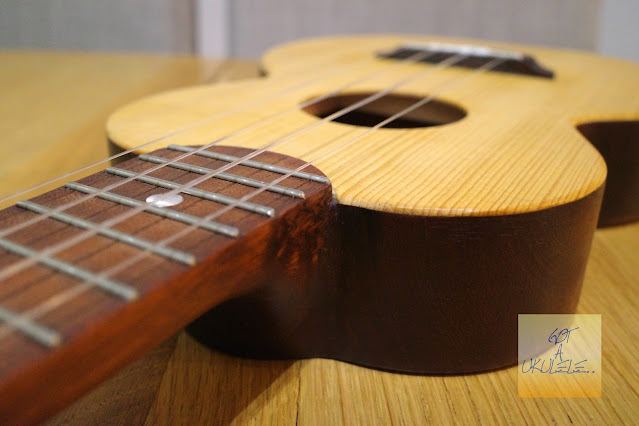


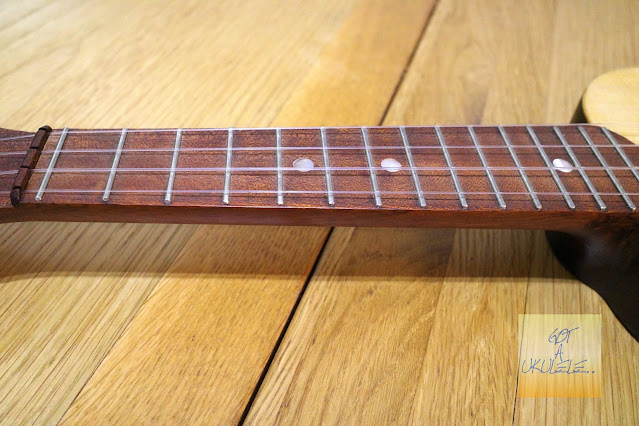
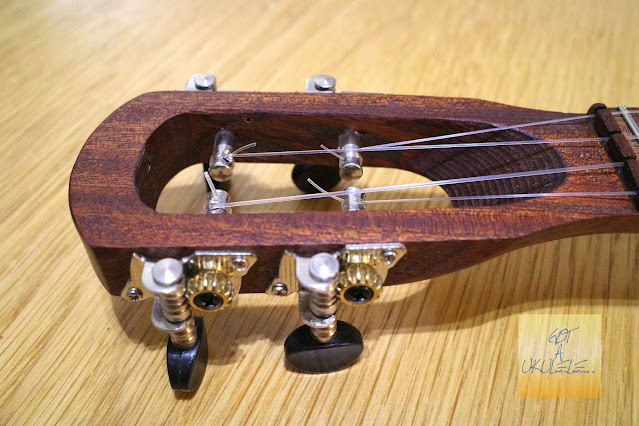
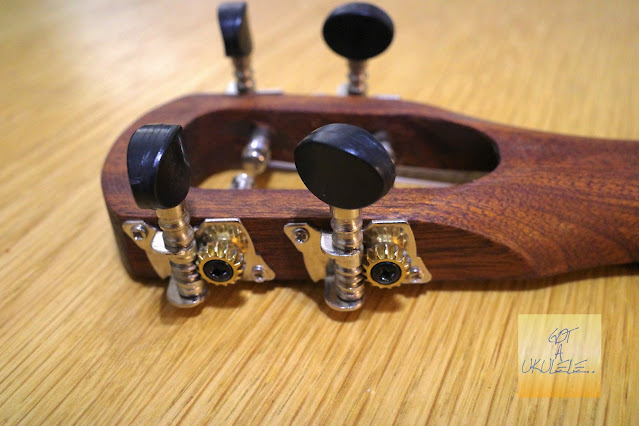
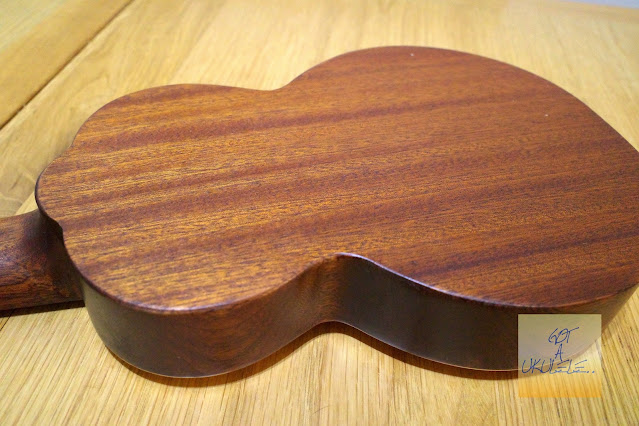

I think it is a great thing that luthiers send you instruments to review, because it's the lack of independent reviews that cause me to hesitate in buying a luthier-built ukulele. Maybe I should just start tagging by name all the luthiers who sell their work on Reverb to see if I can convince them to send you instruments? Hmmm, I'm not sure that would be a favor.
ReplyDeleteIf they are willing to lend them, i'm willing to review them! Always like looking at new names!
DeleteWhen I tried to place an order, the only country available for shipping was France. I asked if they could send to the US - waiting for a reply.
ReplyDeleteThis comment has been removed by a blog administrator.
ReplyDeleteI believe the string issue can also be because of the headstock angle (or lack of angle). A lower angle at the nut will result in a perceived “looser” tension.
ReplyDelete/Gustaf
Yes it can do - but much more to do with gauge.
DeleteI'm impressed by this review and interested in these instruments, but wonder if the actual cost would be much more as I have heard that Customs charges will apply, in addition to postage. Do you know if that is true?
ReplyDeleteDepends what country you are in. When this came to me in the UK it was hit with about £50 VAT and duty
Delete